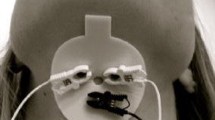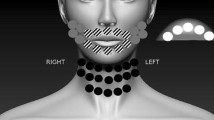Abstract
Few studies have examined the intensity of muscle activity during swallowing in healthy humans. We examined selected hyoid muscles using fine wire intramuscular electromyography (EMG) during swallowing of four food consistencies. Thirteen healthy adults were studied using videofluorography and EMG of the anterior belly of digastric (ABD), geniohyoid (GH), sternohyoid (SH), and masseter (MA; surface electrodes) while ingesting thin liquid (three trials) and solid food of three consistencies (banana, tofu, and cookie, three trials each). After rectification, integration, and normalization, peak EMG amplitudes for each muscle in each trial were measured. Hyoid displacements were measured in two dimensions. Data were analyzed using repeated measures ANOVA with Bonferroni correction. GH had the highest adjusted amplitude for both solids and liquid. For MA and ABD, amplitude was highest with triturated cookie. For ABD, amplitude was lowest with liquid. There were no significant food consistency effects for GH or SH. Hyoid displacements were greatest for cookie and the lowest for liquid. EMG amplitude varied with initial food consistency. The high peak EMG amplitude of GH is consistent with its essential role in opening the upper esophageal sphincter. High MA amplitude with hard solid foods is likely due to the higher tongue-palate pressure with triturated solids. The higher ABD amplitude with solid food is associated with greater hyoid displacement. These findings support the existence of a central pattern generator that modifies the level of muscle activity during pharyngeal swallowing in response to input from mechanoreceptors in the oral cavity.



Similar content being viewed by others
References
Palmer JB, Rudin NJ, Lara G, Crompton AW. Coordination of mastication and swallowing. Dysphagia. 1992;7(4):187–200.
German RZ, Crompton AW, Thexton AJ. Integration of the reflex pharyngeal swallow into rhythmic oral activity in a neurologically intact pig model. J Neurophysiol. 2009;102(2):1017–25.
Vaiman M, Eviatar E, Segal S. Surface electromyographic studies of swallowing in normal subjects: a review of 440 adults. report 1. quantitative data: timing measures. Otolaryngol Head Neck Surg. 2004;131(4):548–55.
Vaiman M, Eviatar E, Segal S. Surface electromyographic studies of swallowing in normal subjects: a review of 440 adults. report 2. quantitative data: amplitude measures. Otolaryngol Head Neck Surg. 2004;131(5):773–80.
Palmer PM, Luschei ES, Jaffe D, McCulloch TM. Contributions of individual muscles to the submental surface electromyogram during swallowing. J Speech Lang Hear Res. 1999;42(6):1378–91.
Basmajian JV, Stecko G. A new bipolar electrode for electromyography. J. Appl. Physiol. (Bethesda, Md.: 1985). 1962;17(5):849.
Palmer JB, Tanaka E, Siebens AA. Electromyography of the pharyngeal musculature: technical considerations. Arch Phys Med Rehabil. 1989;70(4):283–7.
Inokuchi H, Gonzalez-Fernandez M, Matsuo K, Brodsky MB, Yoda M, Taniguchi H, Okazaki H, Hiraoka T, Palmer JB. Electromyography of swallowing with fine wire intramuscular electrodes in healthy human: activation sequence of selected hyoid muscles. Dysphagia. 2014;29(6):713–21.
Palmer PM, Jaffe DM, McCulloch TM, Finnegan EM, Van Daele DJ, Luschei ES. Quantitative contributions of the muscles of the tongue, floor-of-mouth, jaw, and velum to tongue-to-palate pressure generation. J Speech Lang Hear Res. 2008;51(4):828–35.
Palmer PM, McCulloch TM, Jaffe D, Neel AT. Effects of a sour bolus on the intramuscular electromyographic (EMG) activity of muscles in the submental region. Dysphagia. 2005;20(3):210–7.
Konow N, Thexton A, Crompton AW, German RZ. Regional differences in length change and electromyographic heterogeneity in sternohyoid muscle during infant mammalian swallowing. J Appl Physiol. 2010;109(2):439–48.
Holman SD, Waranch DR, Campbell-Malone R, Ding P, Gierbolini-Norat EM, Lukasik SL, German RZ. Sucking and swallowing rates after palatal anesthesia: an electromyographic study in infant pigs. J Neurophysio. 2013;110(2):387–96.
Im I, Kim Y, Oommen E, Kim H, Ko MH. The effects of bolus consistency in pharyngeal transit duration during normal swallowing. Ann Rehabil Med. 2012;36(2):220–5.
Taniguchi H, Tsukada T, Ootaki S, Yamada Y, Inoue M. Correspondence between food consistency and suprahyoid muscle activity, tongue pressure, and bolus transit times during the oropharyngeal phase of swallowing. J Appl Physiol. 2008;105(3):791–9.
Ishida R, Palmer JB, Hiiemae KM. Hyoid motion during swallowing: factors affecting forward and upward displacement. Dysphagia. 2002;17(4):262–72.
Zu Y, Yang Z, Perlman AL. Hyoid displacement in post-treatment cancer patients: preliminary findings. J Speech Lang Hear Res. 2011;54(3):813–20.
Inokuchi H, Brodsky MB, Gonzalez-Fernandez M, Yoda M, Hiraoka T, Matsuo K, Palmer JB. Frequency of stage II oral transport cycles in healthy human. Dysphagia. 2014;29(6):685–91.
Hiiemae KM, Palmer JB. Food transport and bolus formation during complete feeding sequences on foods of different initial consistency. Dysphagia. 1999;14(1):31–42.
Hwang J, Kim DK, Bae JH, Kang SH, Seo KM, Kim BK, Lee SY. The effect of rheological properties of foods on bolus characteristics after mastication. Ann Rehabil Med. 2012;36(6):776–84.
Thexton AJ, Crompton AW, German RZ. Electromyographic activity during the reflex pharyngeal swallow in the pig: doty and bosma (1956) revisited. J Appl Physiol. 2007;102(2):587–600.
Campbell-Malone R, Crompton AW, Thexton AJ, German RZ. Ontogenetic changes in mammalian feeding: insights from electromyographic data. Integr Comp Biol. 2011;51(2):282–8.
Spiro J, Rendell JK, Gay T. Activation and coordination patterns of the suprahyoid muscles during swallowing. Laryngoscope. 1994;104(11 Pt 1):1376–82.
Okada T, Aoyagi Y, Inamoto Y, Saitoh E, Kagaya H, Shibata S, Ota K, Ueda K. Dynamic change in hyoid muscle length associated with trajectory of hyoid bone during swallowing: analysis using 320-row area detector computed tomography. J Appl Physiol (1985). 2013;115(8):1138–45.
Holman SD, Konow N, Lukasik S, German RZ. Regional variation in geniohyoid muscle strain during suckling in the infant pig. J Exp Zool A Ecol Genet Physiol. 2012;317(6):359–70.
Humbert IA, Lokhande A, Christopherson H, German R, Stone A. Adaptation of swallowing hyo-laryngeal kinematics is distinct in oral vs. pharyngeal sensory processing. J Appl Physiol. 2012;112(10):1698–705.
Steele CM, Miller AJ. Sensory input pathways and mechanisms in swallowing: a review. Dysphagia. 2010;25(4):323–33.
Dantas RO, Dodds WJ, Massey BT, Kern MK. The effect of high- vs low-density barium preparations on the quantitative features of swallowing. AJR Am J Roentgenol. 1989;153(6):1191–5.
Yokoyama S, Hori K, Tamine K, Fujiwara S, Inoue M, Maeda Y, Funami T, Ishihara S, Ono T. Tongue pressure modulation for initial gel consistency in a different oral strategy. PLoS ONE. 2014;9(3):e91920.
Dantas RO, Dodds WJ. Effect of bolus volume and consistency on swallow-induced submental and infrahyoid electromyographic activity. Braz J Med Biol Res. 1990;23(1):37–44.
Hickenbottom RS, Bishop B, Moriarty TM. Effects of whole-body rotation on masseteric motoneuron excitability. Exp Neurol. 1985;89(2):442–53.
Rouaud T, Magot A, Guiheneuc P, Perrouin Verbe B, Truffert A, Pereon Y. Experimental study of a late response recorded from the thoracic wall after phrenic nerve stimulation. Clin Neurophysiol. 2009;120(8):1543–7.
Acknowledgments
The late Dr. Karen Hiiemae contributed immensely to this work. We would like to thank Chune Yang for her extraordinary technical support and assistance. We appreciate the advice offered by Drs. Rebecca Z. German and Alan Thexton. This research was supported in part by NIH/NIDCD Award No. R01-DC02123. We presented this study in part at the 21st Annual Meeting of Dysphagia Research Society, Seattle, WA, USA. March 13–16, 2013 and the 19th Annual Meeting of the Japanese Society of Dysphagia Rehabilitation, Okayama, Japan, September 22–23, 2013.
Author information
Authors and Affiliations
Corresponding author
Ethics declarations
Conflict of interest
The authors report no conflict of interest.
Rights and permissions
About this article
Cite this article
Inokuchi, H., González-Fernández, M., Matsuo, K. et al. Electromyography of Swallowing with Fine Wire Intramuscular Electrodes in Healthy Human: Amplitude Difference of Selected Hyoid Muscles. Dysphagia 31, 33–40 (2016). https://doi.org/10.1007/s00455-015-9655-9
Received:
Accepted:
Published:
Issue Date:
DOI: https://doi.org/10.1007/s00455-015-9655-9




